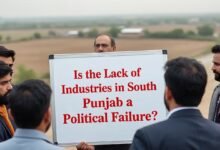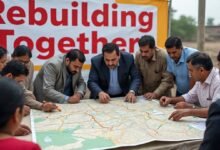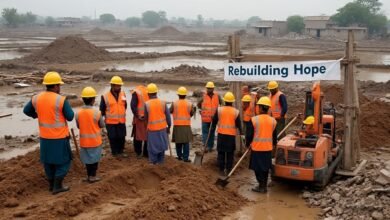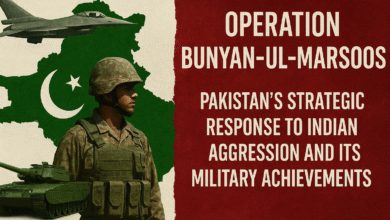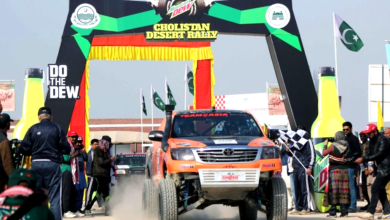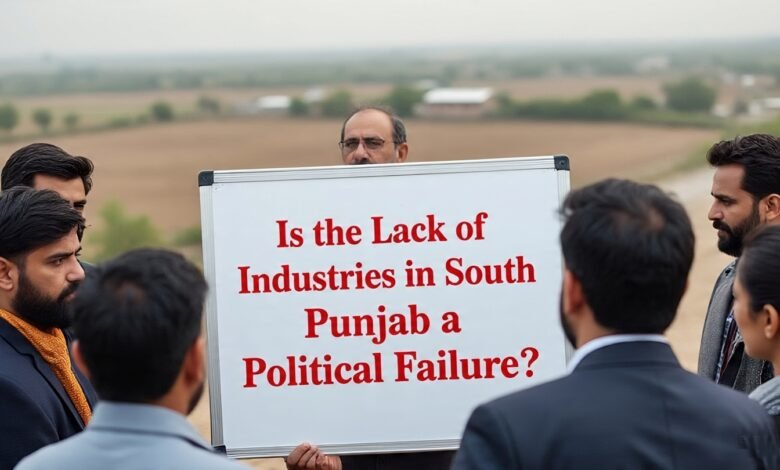
Is the Lack of Industries in South Punjab a Political Failure?
South Punjab's industrial lag behind North Punjab reveals deep political neglect. Explore how governance failures created Pakistan's most deprived region despite vast potential.
South Punjab, comprising nearly 57% of Punjab province’s total area and housing 36% of its population, stands as Pakistan’s most industrially underdeveloped region despite its vast agricultural potential and strategic location. While North Punjab thrives with industrial clusters in Lahore, Gujranwala, and Sialkot, South Punjab remains trapped in a cycle of economic stagnation that many experts attribute to systematic political failure and government neglect.
The stark contrast between regions is undeniable. Sialkot District in the prosperous northern part of the province has a poverty rate of 5.63%, while Rajanpur District in the poorer south has a poverty rate of 60.05%. This disparity raises fundamental questions about political priorities, resource allocation, and the role of governance in regional development. According to recent UNDP reports, South Punjab is the most deprived region in the province in terms of basic services, such as sanitation facilities, and data shows only 56.2 per cent of the population uses improved sanitation facilities.
This analysis examines whether the lack of industries in South Punjab represents a systematic political failure, exploring the complex interplay between historical policies, political representation, and economic development strategies that have shaped the region’s industrial landscape.
Understanding South Punjab’s Industrial Deficit
Geographic and Economic Context
South Punjab encompasses the Multan Division, Bahawalpur Division, and Dera Ghazi Khan Division, along with parts of the Sahiwal Division. This vast region, blessed with fertile agricultural land and significant water resources from the Indus River system, should theoretically be an industrial powerhouse. However, the reality tells a different story.
Punjab is Pakistan’s most industrialized province, with the industrial sector comprising 24 percent of the province’s gross domestic product. Yet this industrial concentration is heavily skewed toward North Punjab, particularly around Lahore, Gujranwala, and Sialkot. Lahore and Gujranwala Divisions have the largest concentration of small light engineering units. The district of Sialkot excels in sports goods, surgical instruments, and cutlery goods.
The Numbers Don’t Lie
The industrial disparity between North and South Punjab is not merely anecdotal but backed by hard data:
- Poverty rates: North Punjab districts average under 10% poverty, while South Punjab districts often exceed 40-60%
- Industrial employment: Less than 15% of South Punjab’s workforce is employed in manufacturing, compared to over 30% in North Punjab
- Per capita income: South Punjab’s per capita income is approximately 40% lower than North Punjab
- Infrastructure investment: Historical data shows 70% of industrial infrastructure spending concentrated in North Punjab
About 55pc of the population is living below 50pc of median income (per capita) in the rural south region of Punjab. Thirty-one per cent of the population in the south is living below the national poverty line whereas this percentage is lower in centre and north Punjab.
Historical Context: Colonial Legacy and Early Policy Decisions
Colonial Foundations of Inequality
The roots of South Punjab’s industrial underdevelopment trace back to British colonial policies. British plans to develop Southern Punjab along similar lines to the Canal Colonies were not implemented during the latter years of colonial rule; perennial irrigation materialised after independence.
The colonial administration deliberately concentrated industrial development in certain regions while treating others as mere suppliers of raw materials. This pattern established a center-periphery relationship that independent Pakistan inherited and, unfortunately, perpetuated.
Post-Independence Policy Choices
After 1947, Pakistan’s industrial policy makers made crucial decisions that would shape South Punjab’s economic trajectory for decades:
- Concentration strategy: Early industrial policies focused on creating industrial clusters rather than distributed development
- Infrastructure priorities: Major transportation and communication networks were built to connect existing industrial centers
- Financial sector development: Banking and investment institutions were concentrated in Karachi and Lahore
- Educational infrastructure: Technical and higher education institutions were predominantly established in North Punjab
At the time of independence in 1947, both India and Pakistan inherited a weak industrial infrastructure, but the areas that became Pakistan were particularly underdeveloped. The British had concentrated their industrial efforts in regions like Bengal, Bombay, and Madras, leaving Pakistan’s territories, including its economic heartland Punjab, with minimal industrial facilities — only 34 industrial units.
Political Representation and Power Dynamics
The Question of Political Voice
One of the most significant factors contributing to South Punjab’s industrial lag is the region’s political underrepresentation and the nature of its political leadership. One apparent reason behind all these acts of apathy is that national and provincial legislators from backward areas, like South Punjab, after being elected usually remain in either Islamabad or Lahore in their luxury homes, and rarely go back to the people who vote them to power.
This absentee representation creates a vicious cycle where:
- Local issues remain unaddressed at provincial and federal levels
- Development priorities are set by people with limited ground-level understanding
- Resource allocation favors regions with stronger political advocacy
- Policy implementation lacks local ownership and monitoring
Feudal Politics and Industrial Development
South Punjab’s political landscape is dominated by feudal politics, which has historically hindered industrial development:
- Large landowners often oppose industrialization that might reduce their labor supply
- Political dynasties maintain power through traditional patron-client relationships rather than development-based legitimacy
- Resource extraction mentality prioritizes short-term gains over long-term industrial investment
- Limited middle class reduces demand for industrial diversification
Another thorny issue is that of tribal feuds and enmity that make an impact on the voting pattern of people in most backward areas.
Government Policy Failures and Missed Opportunities
Industrial Policy Vacuum
One of the most glaring political failures has been the absence of a coherent industrial policy specifically designed for South Punjab. Unfortunately, Pakistan never had any such policy document. The provincial industries departments are more focused on controlling industries, rather than promoting them.
This policy vacuum has resulted in:
- Ad hoc decision making without strategic vision
- Reactive rather than proactive industrial promotion
- Lack of coordination between federal and provincial initiatives
- Absence of performance benchmarks for regional development
Infrastructure Neglect
Infrastructure development has been consistently biased toward North Punjab, creating a self-reinforcing cycle of industrial concentration:
Transportation Networks
- Highway connectivity: Major highways prioritize North Punjab connections
- Railway infrastructure: Freight networks favor existing industrial centers
- Port access: Limited direct connectivity to Karachi Port from South Punjab
Energy Infrastructure
- Power generation: Most thermal and hydroelectric projects located in or near North Punjab
- Gas distribution: Industrial gas supply infrastructure concentrated in North Punjab
- Electricity transmission: Grid infrastructure favors North Punjab industrial areas
Educational and Research Infrastructure
- Technical universities: Concentrated in Lahore and neighboring cities
- Research institutes: Limited presence in South Punjab
- Vocational training: Inadequate industrial skills development programs
Resource Allocation Disparities
On paper, 35pc of the province budget is spent on the region. The reality, however, seems to be quite different. Development programmes for health, education, social services, research and rural development have been initiated a number of times, but most of them fail to reach completion owing to lack of interest on the part of the authorities concerned.
Case Studies: Failed Projects and Broken Promises
The Thal Medical College Saga
In 2012, the government at the time had approved the establishment of Thal Medical College in Bhakkar, but the project remains what it was always meant to be; a mere political stunt to make headlines. No one knows why even after 10 years, the ‘approved’ medical college has not been established.
This case exemplifies the pattern of political promises followed by implementation failures that characterizes South Punjab’s development experience.
Industrial Estate Development
Multiple industrial estates have been announced for South Punjab over the decades, but few have materialized with adequate infrastructure:
- Lack of utilities: Promised electricity and gas connections often delayed for years
- Transportation links: Road and rail connectivity frequently inadequate
- Financial services: Banking and investment facilities rarely co-located with industrial sites
- Support services: Technical services and spare parts suppliers absent
The CPEC Opportunity Missed
The China-Pakistan Economic Corridor (CPEC) presented a historic opportunity for South Punjab’s industrial development. However, most CPEC industrial projects have been located in North Punjab or other provinces, perpetuating the existing pattern of regional inequality.
Economic Consequences of Political Failure
Human Capital Flight
The lack of industrial opportunities in South Punjab has created a massive brain drain:
- Educated youth migrate to Lahore, Karachi, or abroad
- Entrepreneurial talent seeks opportunities in more developed regions
- Technical skills developed through education are exported rather than utilized locally
- Innovation capacity remains underdeveloped due to talent exodus
Agricultural Sector Stagnation
While South Punjab excels in agriculture, the absence of agro-processing industries has limited value addition:
- Raw material exports: Cotton, wheat, and other crops exported without processing
- Price volatility: Farmers vulnerable to commodity price fluctuations
- Limited employment: Agriculture alone cannot absorb the growing workforce
- Technology gaps: Limited industrial demand reduces incentives for agricultural innovation
Social Development Indicators
The industrial deficit has broader social implications reflected in key development indicators:
- Healthcare access: 8.4pc of individuals in north Punjab were spending more than 10pc of their monthly consumption expenditure on healthcare, followed by south Punjab where 6.8pc spent more
- Gender equality: Only 28pc of women in south Punjab own mobile phones
- Child welfare: A very high percentage (20pc) of girls getting married before the age of 18
Recent Political Initiatives: Too Little, Too Late?
South Punjab Secretariat
In 2020, the Pakistan Tehreek-e-Insaf (PTI) government established a separate South Punjab Secretariat as a step toward addressing regional grievances. In 2020, a separate civil secretariat was established for South Punjab. The secretariat was made up of Dera Ghazi Khan Division, Multan Division, and Bahawalpur Division. It became officially operational on 15 October 2020.
However, critics argue this initiative falls short of genuine administrative autonomy:
- Limited powers: Many decisions still require approval from Lahore
- Resource constraints: Budget allocation remains controlled centrally
- Implementation gaps: Ground-level change limited despite bureaucratic restructuring
Provincial Status Movement
On 28 January 2022 the Senate of Pakistan accepted a bill seeking the creation of South Punjab province, and was supported by the Pakistan Tehreek-e-Insaf (PTI) and Pakistan People’s Party (PPP).
The South Punjab province movement represents growing political recognition of regional grievances, but implementation remains uncertain due to:
- Political opposition: Some parties oppose provincial division
- Constitutional requirements: Complex process requiring broad consensus
- Resource sharing: Disputes over revenue and asset distribution
- Administrative challenges: Questions about governance capacity and infrastructure
Comparative Analysis: Learning from Success Stories
Gujarat Model in India
Indian Punjab has faced similar challenges but has seen more balanced industrial development through:
- Deliberate policy intervention to promote industrial clusters in lagging regions
- Infrastructure investment connecting rural areas to industrial centers
- Educational policy emphasizing technical skills development across regions
- Financial inclusion ensuring credit access for small and medium enterprises
Regional Development in China
China’s approach to regional inequality offers lessons for South Punjab:
- Special economic zones in underdeveloped regions
- Technology transfer programs linking developed and developing areas
- Infrastructure connectivity projects prioritizing lagging regions
- Governance reforms providing greater autonomy to regional authorities
The Path Forward: Policy Recommendations
Immediate Policy Interventions
Industrial Policy Framework
- Develop a South Punjab-specific industrial policy with clear targets and timelines
- Establish industrial clusters based on regional comparative advantages
- Create investment incentives specifically for South Punjab industrial projects
- Streamline regulatory processes for industrial setup in the region
Infrastructure Development
- Prioritize transportation connectivity linking South Punjab to national and international markets
- Upgrade energy infrastructure ensuring reliable power and gas supply
- Develop industrial parks with modern utilities and support services
- Improve telecommunications infrastructure for digital connectivity
Human Capital Development
- Establish technical universities and research institutes in South Punjab
- Create vocational training programs aligned with industrial needs
- Develop entrepreneurship programs to nurture local business talent
- Facilitate technology transfer from developed regions
Long-term Structural Reforms
Governance Reforms
- Enhance local governance structures with greater autonomy
- Improve political representation ensuring South Punjab voices are heard
- Strengthen accountability mechanisms for development spending
- Promote participatory planning involving local communities and businesses
Financial Sector Development
- Establish regional development banks focused on industrial financing
- Create investment funds specifically for South Punjab projects
- Develop capital markets to mobilize local savings for investment
- Improve insurance services to reduce business risks
International Development Support and UNDP Initiatives
UNDP Partnership
The United Nations Development Programme (UNDP) has recognized the challenges facing South Punjab and has launched several initiatives to address regional inequality. UNDP is providing technical support and strategic partnership to South Punjab to reduce regional inequalities. We are working together for the effective localization of Sustainable Development Goals to leave no one behind.
Key UNDP initiatives include:
- SDGs localization programs for evidence-based policymaking
- Socio-economic baseline profiling of South Punjab districts
- District development plans for Multan, Bahawalpur, and Rahim Yar Khan
- Policy support for inclusive and equitable development
World Bank Engagement
The World Bank has also been involved in South Punjab development through various projects:
- Flood rehabilitation programs in South Punjab districts
- Educational infrastructure development in underserved areas
- Agricultural productivity enhancement projects
- Climate resilience initiatives for disaster-prone regions
These international partnerships provide both technical expertise and financial resources, but their impact depends largely on political will and effective implementation by Pakistani authorities.
The Role of Private Sector and Entrepreneurship
Challenges Facing Private Investment
Private sector development in South Punjab faces multiple constraints that reflect broader governance failures:
Regulatory Environment
- Complex approval processes for industrial licensing
- Inconsistent policy implementation creating uncertainty for investors
- Bureaucratic delays in project approvals and clearances
- Lack of one-window operations for business facilitation
Market Access
- Limited transportation infrastructure increasing logistics costs
- Weak backward linkages with suppliers and service providers
- Distance from major markets affecting competitiveness
- Limited export facilitation services
Financial Constraints
- Limited banking infrastructure in rural South Punjab
- Higher interest rates due to perceived regional risks
- Inadequate venture capital for startup enterprises
- Limited insurance coverage for industrial risks
Success Stories and Potential
Despite challenges, some private sector success stories in South Punjab demonstrate the region’s potential:
- Agro-processing units in Multan and Bahawalpur
- Textile manufacturing in Faisalabad’s neighboring areas
- Food processing industries utilizing local agricultural produce
- Small-scale manufacturing serving local and regional markets
These examples suggest that with appropriate policy support and infrastructure development, South Punjab could attract significant private investment and develop a thriving industrial ecosystem.
Environmental and Sustainability Considerations
Industrial Development vs. Environmental Protection
Any industrial development strategy for South Punjab must balance economic growth with environmental sustainability:
Water Resources Management
- Industrial water usage must be planned considering agricultural needs
- Wastewater treatment facilities essential for environmental protection
- Groundwater conservation critical given declining water tables
- River pollution prevention to protect the Indus River ecosystem
Air Quality Concerns
- Industrial emissions standards must be enforced from the beginning
- Clean technology adoption should be incentivized
- Transportation planning to minimize air pollution
- Urban planning to prevent industrial-residential conflicts
Climate Change Adaptation
- Flood-resistant infrastructure given South Punjab’s vulnerability
- Heat-resilient industrial design for extreme weather conditions
- Renewable energy integration for sustainable industrial growth
- Carbon footprint minimization aligned with global climate goals
Gender and Social Inclusion in Industrial Development
Women’s Economic Participation
Only 28pc of women in south Punjab own mobile phones, highlighting significant gender gaps that any industrial development strategy must address:
Employment Opportunities
- Women-friendly industrial policies to increase female workforce participation
- Skills training programs targeting women in rural South Punjab
- Childcare facilities in industrial areas to support working mothers
- Transportation safety to enable women’s mobility for work
Entrepreneurship Support
- Women-specific business financing programs
- Mentorship networks for female entrepreneurs
- Market linkage programs connecting women producers to larger markets
- Technology access to bridge the digital gender divide
Social Inclusion Measures
Industrial development in South Punjab must be inclusive, addressing the needs of:
- Religious minorities who face discrimination in employment
- Persons with disabilities requiring accessible workplace design
- Youth populations needing skills development and employment opportunities
- Marginalized communities requiring special support for economic integration
Technology and Innovation Potential
Digital Transformation Opportunities
South Punjab has significant potential for technology-enabled industrial development:
E-commerce and Digital Markets
- Online marketplaces for agricultural and artisanal products
- Digital payment systems to formalize the economy
- Supply chain digitization to improve efficiency
- Export facilitation through digital platforms
Industry 4.0 Applications
- Smart manufacturing in agro-processing industries
- IoT applications for agricultural productivity
- Data analytics for market intelligence
- Automation technologies for competitive manufacturing
Innovation Ecosystems
- Technology incubators in major South Punjab cities
- University-industry linkages for research and development
- Innovation competitions to identify promising entrepreneurs
- Technology transfer programs from developed regions
Regional Connectivity and Trade Opportunities
CPEC and Regional Integration
South Punjab’s location offers strategic advantages for regional trade that remain underutilized due to political failures:
Afghanistan Trade
- Border trade facilities in Dera Ghazi Khan region
- Warehousing and logistics for Afghanistan-bound goods
- Transit trade services generating employment and revenue
- Cross-border industrial cooperation in specific sectors
Central Asian Connectivity
- Transportation corridors connecting to Central Asian markets
- Energy cooperation opportunities with regional countries
- Agricultural exports to food-deficit regional markets
- Cultural and economic exchanges building regional ties
Internal Market Integration
Better connectivity within Pakistan could transform South Punjab’s economic prospects:
- Karachi Port connectivity for export-oriented industries
- Lahore market access for South Punjab manufacturers
- Inter-provincial trade facilitation
- Supply chain integration across regions
Measuring Success: Key Performance Indicators
Economic Indicators
- Industrial employment as percentage of total workforce
- Manufacturing value addition per capita
- Private investment flows to South Punjab
- Export earnings from South Punjab industries
- Per capita income convergence with North Punjab
Social Development Indicators
- Poverty reduction rates across South Punjab districts
- Human Development Index improvements
- Gender equality measures in economic participation
- Educational attainment levels, especially technical education
- Healthcare access and quality indicators
Governance Indicators
- Project completion rates for announced development initiatives
- Budget utilization efficiency for South Punjab allocations
- Citizen satisfaction with government services
- Transparency measures in development spending
- Political representation effectiveness in addressing regional needs
Conclusion
The lack of industries in South Punjab represents a clear case of political failure spanning multiple decades and governments. While the region possesses abundant natural resources, strategic location, and human potential, systematic policy neglect, resource misallocation, and governance failures have created Pakistan’s most industrially underdeveloped region. The stark disparity between North and South Punjab—exemplified by poverty rates ranging from 5.63% in Sialkot to 60.05% in Rajanpur—reflects not geographical determinism but deliberate policy choices that have concentrated development in already prosperous areas. Recent initiatives like the South Punjab Secretariat and proposed provincial status represent political recognition of these failures, but meaningful change requires comprehensive policy reform, infrastructure investment, and genuine political commitment to regional equity. Without addressing the fundamental governance issues that created this disparity, South Punjab will remain trapped in its cycle of underdevelopment, representing a massive waste of Pakistan’s economic potential and a continued injustice to its 40 million residents.
